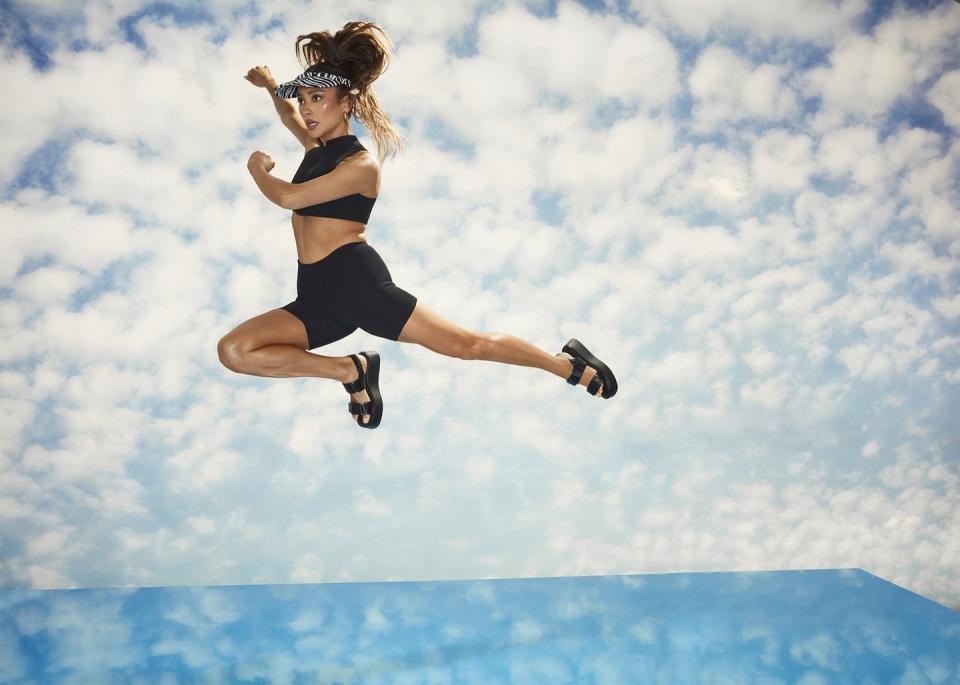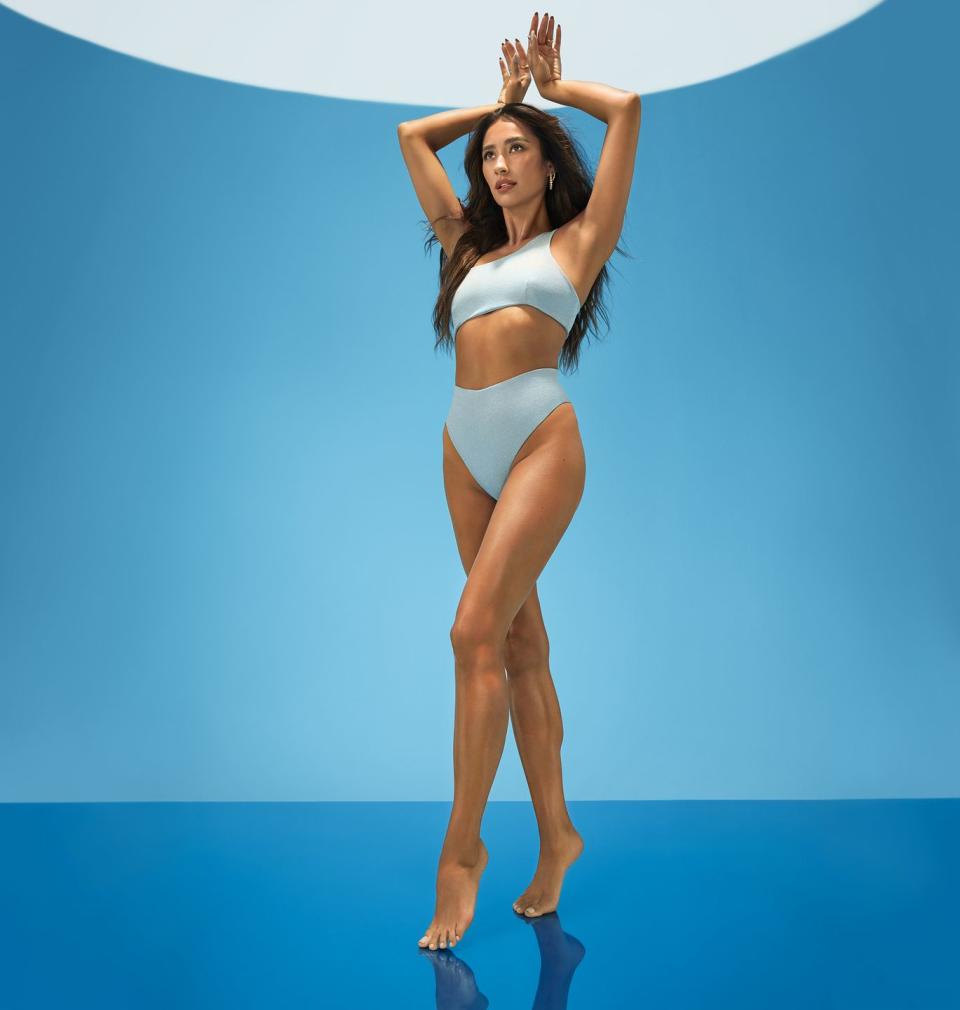Shay Mitchell Says A 4-Week Workout Challenge ‘Changed Everything’ For Her Post-Baby
In the first year and a half of her life, Shay Mitchell’s daughter, Atlas Noa Babel, learned how to crawl, walk, wave, point to birds in the sky, pick up rocks and offer them as presents, eat spinach off her parents’ plates, and parrot things her mother says, like: “I don’t knoooow!” It took that same time period—one and a half years, during which her baby has changed countless times—for Shay to finally feel like her pre-pregnant self.
“I hit the pause button,” she says of the confluence of a newborn, a pandemic, and a life devoid of travel and social activities. The actress felt lucky to be present with her partner, Matte, and Atlas, who was 5 months old when the pandemic ramped up, yet she was also unmotivated. “I was like, ‘Well, what am I getting ready for?’” she says, reflecting on how little she moved. Atlas wasn’t mobile, so Shay spent a lot of time with her on the floor. “Everything just went whoooomp,” she says, articulating the slowed pace of everything.
In January, a partnership with Openfit—in which she and friend Stephanie Shepherd committed to working out five days a week for four weeks, via classes on the app—made her take stock. Part of what attracted her to the partnership was that she would have to treat working out like a job. Twenty days of accountability. “It changed everything,” the 34-year-old says of finally feeling like herself again. “I had way more energy; I don’t have five cups of coffee anymore. I can sound preachy when I’m talking about it, but it totally altered my year."
Try This 4-Week Workout Challenge From Women's Health
But then the Internet came. Shay posted a photo to Instagram, showing split screens of her body before she committed to the plan and after. She wrote that she felt more “healthy, energetic, and engaged.” The comments popped off. People alleged that this was merely the same photo taken from two different angles; that she was criticizing people for being overweight; that she wasn’t grateful for her post-baby body. It bothered Shay, because she was proud of the work she had put in—and in her view, she was promoting health, not vanity. “Right after I had Atlas, if I ever made a comment about how I didn’t feel like myself, people were like, ‘Well, you just had a baby.’ Yeah, I know I just had a baby,” she says pointedly. “I’m very grateful for my body, and that it gave life, but I’m still allowed to express that I don’t feel like myself.”
Watch Shay Mitchell give you a tour inside her fridge:
Shay dealt with prepartum depression while carrying Atlas, and being open taught her that honesty about motherhood is the only way. “I was strong before I had Atlas, and I wanted to feel that way after,” says Shay. “We celebrate our bodies before we’re pregnant; we celebrate our bodies with bumps. We should also celebrate our bodies at whatever point we feel our best again.”
Trainer Kelsey Heenan led Shay and Stephanie through a mix of cardio and strength training that changed daily. They did HIIT workouts, EMOMs (every minute on the minute), jump squats, arm and leg raises, and squat presses. “For me, it was always about a deadlift,” Shay says. “Getting up to 50 pounds was a boss move. I was really proud of myself.” She can now do pushups and has added a “life-changing” roster of stretches—spidermans, thoracic rotations, arm sweeps—to her post-workout routine. Occasionally, she’ll supplement with rope jumping or hikes in Vancouver, where she’s spent much of the past year hanging with her parents and benefiting from their 24/7 childcare.
Vancouver is where I reach her when we talk about her newfound fitness routine, but also about the mood at her parents’ house. The day before, eight people in Atlanta—six of them Asian women—died in a shooting. Shay, whose mother is Filipino and father is white, saw some of her own experience reflected in the wave of Asian American racism plaguing the U.S. “It’s something my mom has dealt with her whole life,” Shay says. “When she and my dad were dating in the 1980s in Toronto, their relationship was looked down upon. On the bus with my dad, she would get the worst looks. They would tell me about going into a restaurant and people not serving them. I also saw it in real life,” she continues. “My mom would get derogatory remarks like, ‘Are you the cleaning lady? Are you the nanny?’ And she was like, ‘No, but what is your issue if I was?’ ” Shay wasn’t spared either. “In school I was bullied—I’d get questions like, ‘Are you going to go clean the bathrooms?’”

It’s something she thinks about from a different perspective now as she parents a mixed-race child. “Matte is half white—his dad is from Trinidad. And Atlas is a mix of all of us. But she’s very fair-skinned and has light eyes and hair, so she doesn’t look like either of us,” Shay says. “We’re learning how to have those appropriate conversations. It starts with her dolls, with the toys she plays with, and the books we read to her, that have all different colors and ethnicities.”
These were the kinds of discussions Shay didn’t think about when she was pregnant; even 18 months in, she still has moments of disbelief that she is someone’s mother. “To be honest, I think it was attached to my prepartum depression,” she says of realizing that the life she lived was going to be put to rest…and that this was okay. Her doula told her, “A new version of you will be birthed with this baby.” In other words, “Yes, you are going to lose something—but what you gain, obviously, is so worth it.”

Shay’s prepartum struggles were helped in part by talking to friends. “And then, of course, seeing Atlas for the first time, I forgot everything,” she says. (By “everything,” she is referring to hormone-fueled tears, fatigue, and hands so swollen they wouldn’t close.) “Moments after she was born, I said to Matte, ‘Okay, I’m ready to do this again!’ ” For the moment, however, it’s just the three of them. And Shay continues to focus on getting back to herself, which includes nourishing her body through “healthy-ish” eating. “I wish I could say it was all quinoa, salmon, and asparagus, but it’s not,” she says. She starts the day with water and lemon, followed by the “perfect breakfast quesadilla” from TikTok: eggs, spinach, cheese, and olive oil. She has a snack around 11 a.m.; at her parents’, it’s fruit—mango, grapefruit, strawberries. For lunch, she has soup—something like pho, or chicken and macaroni. Then there will be cheese and vegetables and a glass of wine around 4 p.m. Shay eats dinner around 6:30, usually a balance of starch and vegetables, like noodles and veggies, with a salad. For dessert, it’s two of “these crazy caramel-chocolate cookies from Costco” or Lily’s chocolate-covered almonds.
Now that she’s harnessed this sense of balance, what will life be like for Shay as everything opens back up? She’ll be happy to be around coworkers in real life; to meet up with friends for a cycling class. She’ll follow her curiosity, whether that means making a bucket list of places to show Atlas; overseeing the look and feel of two companies she cofounded, Beis and Onda; or voicing the protagonist in Netflix’s adaptation of the Filipino graphic novel Trese.
“People are like, ‘Why?’ and I’m like, ‘Well, why not?’” she says of jumping into a variety of projects. “Look, I have one life to live. I don’t want to say, ‘What if?’”

This article originally appeared in the June 2021 issue of Women’s Health; the digital version has been updated with additional quotes.
Photographed by Dennis Leupold; Fashion Director: Kristen Saladino; Stylist: Monica Rose; Makeup: AshK Holm for Buxom Cosmetics at The Wall Group; Hair: Jesus Guerrero for OGX for The Wall Group; Set design: Ward Robinson for Wooden Ladder
You Might Also Like

